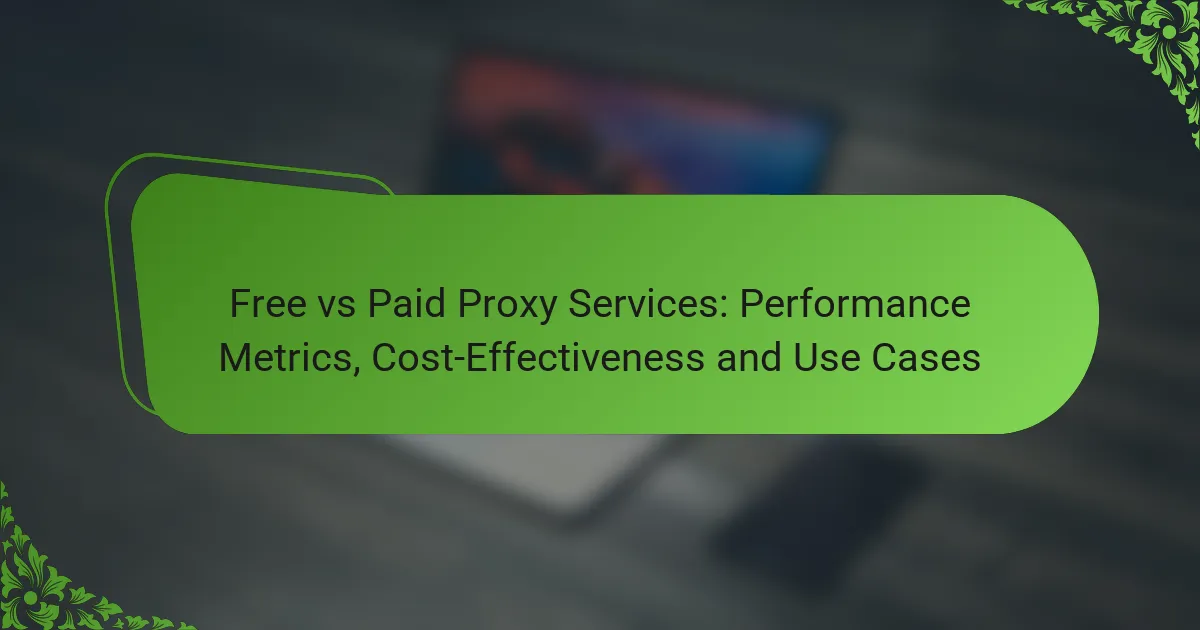Proxy uptime is essential for ensuring business continuity, particularly in the UK, as it keeps services accessible and operational. By monitoring critical performance metrics such as uptime percentage and response time, organizations can minimize disruptions and protect their reputation. A well-defined Service Level Agreement (SLA) further reinforces this reliability by outlining expectations and responsibilities between service providers and clients.

How does proxy uptime impact business continuity in the UK?
Proxy uptime is crucial for maintaining business continuity in the UK, as it ensures that services remain accessible and operational. High availability of proxy servers minimizes disruptions, which can lead to financial losses and damage to reputation.
Ensures uninterrupted access to services
Reliable proxy uptime guarantees that users can consistently access online services without interruptions. This is particularly important for businesses that rely on web applications, as any downtime can result in lost transactions and customer dissatisfaction.
For example, e-commerce platforms depend on proxies to manage traffic and deliver content. If a proxy fails, customers may experience delays or be unable to complete purchases, directly impacting revenue.
Minimizes downtime risks
Maintaining high proxy uptime reduces the risk of downtime, which can be costly for businesses. A well-implemented Service Level Agreement (SLA) should specify acceptable uptime percentages, typically aiming for 99.9% or higher.
To minimize risks, businesses should regularly monitor proxy performance and have contingency plans in place. This may include using multiple proxies or failover systems to ensure continuity during outages.

What performance metrics are critical for proxy reliability?
Critical performance metrics for proxy reliability include uptime percentage, response time, and error rates. Monitoring these metrics helps ensure that proxies function effectively, maintaining business continuity and user satisfaction.
Uptime percentage
Uptime percentage measures the time a proxy server is operational and accessible. A high uptime percentage, typically above 99%, indicates reliable service, while lower percentages can lead to significant disruptions in business operations.
To maintain an optimal uptime percentage, regularly monitor server health and perform scheduled maintenance. Implementing redundancy, such as backup proxies, can also enhance reliability and minimize downtime.
Response time
Response time refers to the duration it takes for a proxy to process a request and return a response. Ideally, response times should be in the low tens of milliseconds to ensure a seamless user experience.
To improve response times, optimize server configurations and reduce latency through efficient routing. Regularly testing and benchmarking response times can help identify bottlenecks and areas for improvement.
Error rates
Error rates indicate the frequency of failed requests processed by a proxy. Keeping error rates low, ideally under 1%, is crucial for maintaining user trust and operational efficiency.
To reduce error rates, analyze logs to identify common issues and implement fixes promptly. Regular updates and monitoring can help prevent errors related to outdated software or misconfigurations.

What are the key components of a Service Level Agreement (SLA)?
A Service Level Agreement (SLA) outlines the expectations and responsibilities between a service provider and a client. Key components include uptime guarantees, compensation terms, and performance metrics, which collectively ensure business continuity and reliability.
Uptime guarantees
Uptime guarantees specify the percentage of time a service is expected to be operational. Common benchmarks range from 99% to 99.9999%, with higher percentages indicating greater reliability. For example, a 99.9% uptime guarantee allows for about 8.76 hours of downtime per year, while 99.99% limits it to roughly 52.56 minutes.
When evaluating uptime guarantees, consider the implications for your business operations. A higher guarantee often comes with increased costs, but it can significantly reduce the risk of disruptions. Always ensure that the SLA clearly defines how uptime is measured and reported.
Compensation terms
Compensation terms detail what the service provider will offer in case of service level breaches. This can include service credits, refunds, or even additional services at no charge. For instance, a provider may offer a 10% credit for every hour of downtime beyond the agreed limit.
It’s crucial to understand how compensation is calculated and the process for claiming it. Some SLAs may require clients to report issues within a specific timeframe to qualify for compensation, so be sure to read the fine print.
Performance metrics definitions
Performance metrics define how the service provider’s performance will be measured and reported. Common metrics include response time, resolution time, and throughput. For example, a provider might commit to a response time of under 30 minutes for critical issues and resolution within four hours.
When reviewing performance metrics, ensure they align with your business needs. Metrics should be realistic and achievable, and the SLA should specify the frequency of performance reporting. This transparency helps maintain accountability and allows for continuous improvement in service delivery.

How can businesses measure proxy uptime effectively?
Businesses can measure proxy uptime by utilizing various monitoring tools and setting up custom alerts. These methods provide real-time insights into proxy performance, helping to ensure business continuity and reliability.
Monitoring tools like Pingdom
Monitoring tools such as Pingdom offer comprehensive solutions for tracking proxy uptime. They work by regularly pinging the proxy server to check its availability and response time. This data helps businesses understand performance trends and identify potential issues before they impact operations.
Many of these tools provide dashboards that display uptime percentages, response times, and historical data. A common benchmark for acceptable uptime is 99.9%, which translates to only a few hours of downtime per year. Choosing a tool that fits your specific needs can enhance your monitoring strategy.
Custom alerts for downtime
Setting up custom alerts for downtime is crucial for immediate response to proxy issues. Businesses can configure alerts to notify them via email or SMS when the proxy is down or experiencing performance degradation. This proactive approach allows teams to address problems quickly, minimizing disruption.
When creating alerts, consider thresholds that trigger notifications. For example, alerts can be set for response times exceeding a certain limit, such as 500 milliseconds, or for any downtime lasting longer than a few minutes. Regularly reviewing and adjusting these parameters ensures they remain relevant as business needs evolve.

What are the best practices for ensuring proxy reliability?
Ensuring proxy reliability involves implementing strategies that minimize downtime and maintain consistent performance. Key practices include conducting regular performance audits and employing redundancy strategies to safeguard against failures.
Regular performance audits
Regular performance audits are essential for identifying potential issues that could affect proxy reliability. These audits should assess response times, error rates, and overall system performance to ensure that proxies meet established benchmarks.
Consider scheduling audits on a monthly or quarterly basis, depending on your usage patterns. Use automated tools to streamline the process and generate reports that highlight trends and areas needing improvement.
Redundancy strategies
Implementing redundancy strategies is crucial for maintaining proxy uptime during outages. This can involve setting up multiple proxy servers in different geographic locations to distribute traffic and reduce the risk of a single point of failure.
Utilize load balancers to manage traffic between these servers effectively. Additionally, consider failover mechanisms that automatically redirect traffic to backup servers when the primary ones experience issues. This approach can significantly enhance reliability and performance.

How do UK regulations affect proxy uptime and reliability?
UK regulations significantly impact proxy uptime and reliability by establishing standards for data protection and service continuity. Compliance with these regulations ensures that businesses maintain operational integrity while safeguarding customer data.
Data protection compliance
Data protection compliance in the UK is primarily governed by the UK General Data Protection Regulation (UK GDPR) and the Data Protection Act 2018. These regulations require businesses to implement adequate security measures, which include maintaining reliable proxy services to protect personal data from breaches.
To ensure compliance, organizations should regularly assess their proxy uptime and reliability. This includes monitoring service performance and implementing redundancy measures to minimize downtime, which can lead to data exposure and regulatory penalties.
Industry-specific requirements
Different industries in the UK may have specific requirements regarding proxy uptime and reliability. For example, financial services must adhere to the Financial Conduct Authority (FCA) regulations, which mandate robust systems to ensure continuous access to services and data integrity.
Healthcare organizations must comply with the Health and Social Care Act, which emphasizes the importance of maintaining patient confidentiality and data security. This often necessitates high availability of proxy services to prevent unauthorized access and ensure compliance with industry standards.

What emerging trends are shaping proxy reliability in the future?
Emerging trends in proxy reliability focus on enhanced monitoring, automation, and integration with advanced technologies. These developments aim to improve uptime and performance metrics, ensuring business continuity in an increasingly digital landscape.
AI-driven monitoring solutions
AI-driven monitoring solutions leverage machine learning algorithms to analyze proxy performance in real-time. By identifying patterns and anomalies, these systems can predict potential failures and optimize resource allocation, thus enhancing reliability.
Implementing AI monitoring can significantly reduce downtime. For instance, businesses may experience improvements in response times, often reducing latency to low tens of milliseconds, which is crucial for maintaining user satisfaction.
When adopting AI-driven solutions, ensure that you regularly update your algorithms and models with current data. This practice helps maintain accuracy and relevance, preventing common pitfalls such as overfitting to outdated performance metrics.







